Carbon Fiber: Furnace & Oven Emission Control
Comments Off on Carbon Fiber: Furnace & Oven Emission Control The Challenge
The Challenge
A carbon fiber company in China was faced with the challenge of selecting an emission control system for a new pilot line at their specialty fiber products facility. The line would include furnaces and three ovens, both of which would emit Carbon Monoxide (CO), Ammonia (NH3), and lethal amounts of Hydrogen Cyanide (HCN).
The Solution
The carbon fiber processor selected Anguil Asia because of their local presence in the region and specific design for this application. Before beginning the project, the Anguil team in Asia ran an energy analysis at the facility, which ensured that the proper technology would be applied based on the destruction requirements, efficiency needs and process parameters. A Direct Fired Thermal Oxidizer (DFTO) was selected to process the furnace exhausts while a Regenerative Thermal Oxidizer (RTO) was chosen to process the oven exhausts.
The Result
To treat the higher concentration exhaust stream coming from the carbon fiber furnaces, Anguil designed a specialized multi-zone DFTO whereby the nitrogen compounds are disassociated at high temperatures in an oxygen depleted chamber. The remaining gases are quenched before moving into a secondary zone where total emission destruction efficiency is over 99% with minimal NOX generation.
The furnace exhausts typically contain tar which often causes plugging in a standard emission control device. Special design considerations were taken to reduce these maintenance concerns and improve reliability. The Anguil system introduces furnace exhaust into the DFTO with a unique inlet manifold that eliminates tar build up and plugging concerns. Anguil also provided an induced draft system for increased safety. This ensures that all of the Hydrogen Cyanide emissions would be drawn into the oxidizer for destruction, protecting the company’s employees and neighborhood from the potentially lethal gas leaking out of flanges, instruments, etc.
Because the customer’s three oxidation ovens were electrically heated, reducing the electrical consumption was a critical objective on this project. As part of the complete energy analysis done at this facility, Anguil understood that the oxidation ovens can require a significant amount of supplemental energy to maintain temperatures from 392°F to 572°F (200°C to 300°C). The customer wanted to recover as much energy as possible from the oxidizer systems to save on the electrical power used in the ovens. Keeping this in mind Anguil proposed several secondary heat exchangers to provide the necessary preheated makeup air back to the electrically heated ovens.
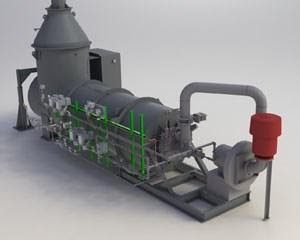
A summary of this energy recovery project is listed below:
- The shell and tube heat exchangers recover approximately 1.0 MMBTU/h (293 kW/h) to be returned as preheated air back to Oven #2 and Oven #3
- The estimated payback on the heat exchangers is less than 3 months
- The shell and tube heat exchanger to preheat combustion air to the DFTO will recover approximately 0.18 MMBTU/h (53 kW/h)
- The estimated payback on the combustion air heat exchanger is less than 7 months (based on a natural gas cost of $10.00/MMBTU and assuming 24 hour/day operation)
To treat the higher flow, lower concentration exhaust from the ovens, Anguil selected an RTO. This type of oxidizer is capable of 98-99%+ destruction efficiency with very low operating costs compared to other emission abatement technologies. With achievable thermal efficiency over 96% the RTO is capable of operating with little to no supplemental fuel use.
During operation the emission laden process gas enters the RTO through an inlet manifold to flow control poppet valves that direct this gas into energy recovery chambers to be preheated. The process gas and contaminants are progressively heated in the ceramic media beds as they move toward the combustion chamber.
Once oxidized in the combustion chamber, the hot purified air releases thermal energy as it passes through the media bed in the outlet flow direction. The outlet bed is heated and the gas is cooled so that the stack temperature is only slightly higher than the process inlet temperature. Poppet valves alternate the airflow direction into the media beds to maximize energy recovery within the oxidizer.
In keeping with the overall goal of the oxidation system to provide all of the required preheated makeup air back to the ovens, Anguil installed a secondary heat exchanger following the RTO. The plate-type heat exchanger recovers 70+% of the RTO exhaust energy. That preheated air is used in lieu of ambient air for the oven.
- The plate heat exchanger will recover approximately 0.42 MMBTU/h (123 kw/h)
- The estimated payback on the heat recovery system is less than 3 months
The project resulted in an overall reduction of emissions and operating expenses for the carbon fiber company. Even on this small pilot line operation, Anguil was able to show a substantial reduction in the overall energy requirement. Due to the success of this project, Anguil will be installing air pollution control equipment on the customer’s full scale production line. The new system will also be energy efficient, keeping with Anguil’s goal of providing air pollution control equipment today to keep our customers profitable tomorrow.
RTO Handles High VOC Loading at Silgan Containers
Comments Off on RTO Handles High VOC Loading at Silgan Containers The Challenge
The Challenge
Regeneration Game – Originally printed in The Canmaker Magazine – Sayers Publishing Group
As the first generation of oxidizer systems in the industry nears the end of their service life, many canmaking plants face repair or replacement of their existing air pollution control systems. Like many others in the industry, a Silgan canmaking plant in the Midwest had been using a thermal recuperative oxidizer with direct heat recovery for control of emissions from its sheet coating lines. After more than a decade of service, the oxidizer was reaching a point that repairs would be needed in order to continue to meet strict compliance limits so Silgan began looking for an effective, efficient solution.
The Solution
Historically, thermal recuperative oxidizers with direct heat recovery have been a popular choice in canmaking facilities – especially those with oven zones operating above 350 deg F (177 deg C).
In the past, thermal recuperative oxidizers had a capital cost advantage over regenerative thermal oxidizers (RTOs) and boasted much more flexible Volatile Organic Compounds (VOC) loading limitations. Their one drawback has always been in supplemental fuel usage. Thermal recuperative oxidizers top out at 70 percent internal heat recovery, whereas RTOs are able to achieve more than 95 percent.
For canmakers, this drawback was minimized with the use of additional heat recovery. Hot, purified air from the oxidizer is routed directly back to the oven zones and not lost to the atmosphere. This has reduced the operating cost ‘penalty’ of the thermal recuperative oxidizer and – in the past – has swung the balance toward specifying that system for VOC loads above ten percent Lower Explosive Limit (LEL) almost exclusively.
So exclusively that, when hearing that Anguil Environmental Systems had recommended an RTO for its Midwest coating facility, Silgan responded almost incredulously: “They recommended what? This is clearly not an RTO application.”
Given the technologies offered when Silgan made its initial selection of a thermal recuperative oxidizer, this was an understandable response. It also served as an ideal framework to study what has changed in oxidizer design over the past decade to reverse such a drastic initial response:
- Thermal recuperative oxidizers no longer have capital cost advantage
- With hot gas bypass and feed forward technology, RTOs are now specified in situations up to 25 percent LEL
- With fuel costs being unstable and still on the rise, every heat recovery percentage points counts
- New requirements for VOC capture plus destruction have marginalized direct heat recovery and increased the operating cost gap between thermal recups and RTOs.
Silgan’s existing thermal recuperative oxidizer was designed based on volume of airflow, organic vapor concentrations and desired destruction efficiency. During operation, VOC-laden air is drawn into the system fan and is discharged into a heat exchanger. The air is preheated through the tube side of the heat exchanger and then passes the burner, where the contaminated air is raised to the thermal oxidation temperature (1,200-1,800 deg F / 650-1,000 deg C). When the VOC-laden air is raised to the thermal oxidation temperature for the specified residence time (0.5-2.0 seconds), an exothermic reaction takes place. The VOCs in the air stream are converted to carbon dioxide and water vapor. The hot, purified air then passes on the shell side of the heat exchanger where the energy released by the reaction is used to preheat the incoming solvent laden air reducing the system’s fuel consumption. Finally, the contaminant-free air is exhausted into the atmosphere.
A weakness in all thermal recuperative oxidizer designs is that the steel in the heat exchanger is exposed to high burner chamber temperatures (typically up to 1600 deg F / 871 deg C). The system at Silgan had a history of requiring ongoing maintenance in this area, which had been driving up cost and impacting throughput. The engineering team at Silgan needed to fix the aging system, replace it with an equivalent, or look for alternative equipment.
After evaluating several options, the RTO selection was based on the capital cost advantage and operating cost savings. It would be a custom-built abatement system designed specifically for this application with high loadings and concentrations. Anguil would design, manufacture and install a 40,000 SCFM (64,200 Nm3/hr) RTO with heat recovery, hot gas bypass and oven purge system.
The Result
Silgan’s new RTO operates as follows:
The solvent laden process gas enters the oxidizer through an inlet manifold. Flow control, poppet valves direct this gas into one of two energy recovery chambers where the process gas is preheated. The process gas and contaminants are progressively heated in the inlet ceramic bed as they move toward the combustion chamber.
The VOCs are oxidized in the combustion chamber, releasing thermal energy in the ceramic bed that is in the outlet flow direction from the combustion chamber. The outlet ceramic bed is heated and the gas is cooled so that the outlet gas temperature is only slightly higher than the process inlet temperature. Flow control, poppet valves routinely alternate the airflow direction into the ceramic beds to maximize energy recovery within the oxidizer. The VOC oxidation and high energy recovery within these oxidizers reduces the auxiliary fuel requirement and saves operating cost. For example, at 95 percent thermal energy recovery, the outlet temperature may be only 70 deg F (40 deg F) higher than the inlet process gas temperature with an RTO. The oxidizer can reach self-sustaining operation with no auxiliary fuel usage at typical operating concentrations. The process emissions at the Silgan facility as well as the temperature of the oven zones presented some challenges, as well as opportunities.
With process LEL levels as high as 14 percent there was a concern over high temperature in the RTO. A hot side bypass valve was provided to allow excess RTO reaction chamber heat to be vented directly into the exhaust or the back to the oven inlet manifold during periods when the inlet VOC loading provides more heat than is necessary to maintain the set point temperature. This primary heat recovery saves thousands of dollars in operating costs because the ovens require much less fuel to reach the desired temperature. With the Anguil design there is no loss of residence time at temperature, ensuring destruction and eliminating the concern of overheating the unit. VOC destruction efficiency is guaranteed whether the bypass is open or not.
Silgan is also investigating another energy reduction strategy by using a secondary heat exchanger to recover additional heat from the RTO exhaust stack. Initial estimates show that an extra 6.5 million btu/hr can be recovered by utilizing a heat exchanger in the oxidizer stack. Fresh air (at an average outdoor temperature of 46 deg F / 8 deg C) passes through a single pass 50 percent effective heat exchanger and is heated up to approximately 350 deg F (177 deg C). This recovered heat can be used for processes or comfort heat during the winter months, which could translate into significant savings.
The RTO is also equipped with a high temperature bake-out system, very similar to the self-cleaning option in an oven. This feature removes organic build-up on the cold face of the heat exchange media. In the bake-out mode, the RTO is taken off-line from the process. At a reduced airflow, the outlet temperature is allowed to reach an elevated temperature before the flow direction is switched. This hot air vaporizes organic particulate, essentially clearing the media bed of any obstruction. The flow direction is then switched and the opposite cold face is cleaned. Standard bake-out occurs at 650 deg F (343 deg C), stainless steel media supports and poppet valves were used on the Silgan system that allowed bake-out temperatures to reach 800 deg F (427 deg C), ensuring a more complete cleaning. Scheduled RTO bake-outs reduce the pressure drop across the heat recovery beds. Therefore, Anguil included the transmitters necessary to monitor media bed pressure drop and provide both continuous recording of this data as well as an indication to the operators when a bake-out is recommended.
Dan Gallo, Silgan’s area manager of manufacturing, was pleased with the outcome. “We selected Anguil because of its technical excellence and commitment to service,” he said. “Not only has the company been able to troubleshoot its own equipment, but Anguil has also provided operating solutions for oxidizers made by other manufacturers. We are pleased with their dedication to excellence and are happy to have Anguil as a business partner.”
* Mike Scholz is a senior application engineer at Anguil Environmental Systems.
Canmaker Achieves Cost-Effective Compliance
Comments Off on Canmaker Achieves Cost-Effective Compliance The Challenge
The Challenge
JL Clark, headquartered in Rockford, Illinois, is no ordinary packager. The company, which celebrated its 115 year anniversary in 2019, is recognized around the world for its award winning metal lithography and exact graphic reproduction.
Also recognized as a long-time positive corporate influence in the community, the management of the company was naturally concerned about the need to comply with US EPA regulations specific to air quality, specifically Volatile Organic Compound (VOC) and Hazardous Air Pollutant (HAP, or air toxics) control. With legislation looming on the horizon, in early 2003 the company began a thorough review of the pending EPA requirements and a corresponding search for a company that could provide a system that would exceed the minimum requirements and do so as cost-effectively as possible.
This was not the first time that JL Clark had taken steps to control their emissions. Years earlier, the company had installed several recuperative thermal oxidizer (RTO) systems that had satisfied earlier requirements but had, over the years, become outdated and was a significant drain on the plant’s operations budget. Costs to operate the systems had become a major component of Clark’s annual fuel usage.
The Solution
After an exhaustive search and thorough review of various proposals, JL Clark selected Anguil to partner with them to meet their emission requirements and at the same time reduce their operational costs. After a kick-off meeting, all parameters were established and agreed upon and work was begun.
The Anguil solution included a 50,000 SCFM (80,250 Nm3/hr) Regenerative Thermal Oxidizer (RTO) to control the emissions and a Permanent Total Enclosure (PTE) to capture the emissions from the plant’s six presses. The selection of the RTO technology was important because it guaranteed the requirement of at least 98% destruction of the VOCs but also because it was seen as an effective way to reduce overall plant operation costs because of its inherent lower operating costs compared with the current VOC control devices.
HOW THE REGENERATIVE THERMAL OXIDIZER WORKS
The Anguil Regenerative Thermal Oxidizer (RTO) destroys air toxics and VOCs that are discharged in industrial process exhausts. The Anguil system achieves VOC destruction through the process of high temperature thermal oxidation, converting the VOCs to carbon dioxide and water vapor, recycling released energy to reduce operating costs.
Process gas with VOC contaminants enters the two chamber RTO through an inlet manifold. A flow control valve directs this gas into an energy recovery chamber which preheats the process stream. The process gas and contaminants are progressively heated in the stoneware bed as they move toward the combustion chamber.
The VOCs are then oxidized, releasing energy in the second stoneware bed, thereby reducing any auxiliary fuel requirement. The stoneware bed is heated and the gas is cooled so that the outlet gas temperature is only slightly higher than the inlet temperature. The flow control valve switches and alternates the stoneware beds so each is in inlet and outlet mode. If the process gas contains enough VOCs, the energy released from their combustion allows self-sustained operation. For example, at 95% thermal energy recovery, the outlet temperature may be only 77° F (25° C) higher than the inlet process gas temperature. PLC-based electronics automatically control all aspects of the RTO operation from start-up to shutdown so that minimal operator interface is required.
THE IMPORTANCE OF THE PERMANENT TOTAL ENCLOSURE
PTEs contribute significantly to the reduction in VOCs released to atmosphere. VOC reduction by a pollution control device only can affect the VOCs delivered to this device. There can still be significant fugitive emissions from the processes which need to be accounted for. For example, older processes with capture efficiencies of 70-85% can result in sufficient emissions that can cause the facility to reach a facility emission cap even with pollution control equipment installed. The installation of a PTE can allow the facility to capture 100% of those process emissions if certain criteria are reached with the PTE design and installation. This high capture rate, along with high VOC destruction rates of new or modified equipment, will significantly decrease the overall emissions from a facility. This reduction can allow for additional expansion of production equipment emitting VOCs without reaching the facility emission limit. The PTE installation can effectively allow for additional production capacity.
In 1990, the EPA issued a capture efficiency guideline which would allow the user the legal presumption of 100% capture efficiency of VOCs without the requirement for formal capture testing. Specifically, the following description applies:
If a source is located inside a “total enclosure” and all emissions are directed to a control device, the requirement to measure the efficiency of capture is waived and presumed 100%. By definition then, a “total enclosure” precludes fugitive emissions. Such an enclosure can be described as a structure that completely surrounds or enshrouds an affected facility such that all VOC emissions are contained and directed through an exhaust stack or into an oven.
THE REGULATION
On November 13, 2003 the US EPA issued a final rule promulgating national emission standards for hazardous air pollutants (NESHAP) for metal can surface coating operations located at major sources of hazardous air pollutants (HAP). These standards (5700 liters/1,500 gallons of coatings per year) dictate that plants affected by this derivative of the Clean Air Act must meet HAP emissions standards reflecting the application of the Maximum Achievable Control Technology (MACT). The standards outline various control requirements based on usage of affected compounds but also provide for emission reduction via a capture system in conjunction with the pollution control device.
The Result
JL Clark’s forward thinking and alliance with Anguil produced a capture system and pollution control device that not only meets the since-enacted EPA requirements but exceeds them. The PTE has proven effective at capturing the emissions from the wet-end coating operations of the process lines-that exhaust is combined with the exhaust from the ovens at the inlet of the RTO. This results in 100% capture efficiency of the VOC/HAP emissions assuring capture efficiency requirements and eventual destruction. The high-efficiency RTO itself has proven to be similarly effective, achieving destruction efficiency in excess of 99% while exceeding all fuel usage reduction objectives! The combined capture and destruction efficiency has therefore exceeded 99% for the facility, minimizing the overall VOC/HAP emissions from the facility and allowing the facility to meet their emissions cap.
The result is a partnership that further enhances JL Clark’s reputation as an industry and community leader and provides Anguil with yet another satisfied customer, one of almost 1,500 around the world.
Coater Replaces Old Oxidizers with Energy Efficient Systems
Comments Off on Coater Replaces Old Oxidizers with Energy Efficient Systems The Challenge
The Challenge
Emission control and the operating costs associated with meeting environmental regulations were nothing new for the Coated Products Division of Brady Corp. The company has been manufacturing coated films for nearly 60 years, demonstrating over that time a commitment to pollution prevention and emission reduction programs. But these considerations were magnified when the Milwaukee coating facility chose to implement a new, energy-efficient emission control system. The division maintains 200 different coating formulas on three main continuously operating process lines. Two of the company’s three coaters are operated as so-called “white rooms” to allow the manufacturing of exceptionally clean products. Applying adhesives, topcoats, cast films and other coatings onto a range of substrates requires solvent-based coatings with mixtures of chemicals. Some of the many solvents used in the process are: toluene, MEK, MIBK, heptane, hexane, ethyl acetate, IPA, nitroethane, nMP, cyclohexanone, and 1,3-dioxolane. The dynamic process stream poses many challenges to the company, particularly in that it eliminates the option of solvent recovery.
The Solution
The capital cost of emission control equipment can be negligible compared to the operating costs if careful consideration is not given to proper equipment selection. With natural gas prices continuing to rise, the company has focused on getting the most efficiency from its incineration equipment. Since the early 1990s, the facility has spent millions of dollars on air pollution control equipment to meet a variety of EPA regulations imposed on coating companies. Including thermal recuperative and regenerative thermal oxidizers (RTOs), as well as concentrator systems, the company has purchased a total of 12 units with a 13th on order for the Milwaukee location alone. The oxidizers have been used to treat everything from coating emissions to low-point floor sweeps located throughout the facility. As natural gas prices started rising in the late 1990s, and with associated costs for emission control equipment steadily increasing, the company looked for ways to reduce their yearly operating and maintenance costs.
The operating and maintenance costs were overwhelming. When one of the old electric RTOs would fail, it generally took over a week to replace the cold face support grid and electric heating elements, and then bring the unit back up to temperature. It occurred so frequently that the maintenance department constructed a special tent so the repairs could be done in the rain or snow. The thermal recuperative oxidizers on site had so many problems with internal heat exchanger failure that a roller system was installed just to move the large duct transition, allowing access to weld the tube sheet without bringing in a crane.
 The Result
The Result
The decision was made to begin replacing the oldest and least efficient oxidizers; the type of systems would be determined by the maintenance team. The first phase of what plant personnel started referring to as its “efficient emission control plan” would replace one of the thermal recuperative oxidizers with a 35,000 SCFM (56,175 Nm3/hr) RTO from Anguil Environmental Systems Inc.
The new system tested out at a destruction efficiency rate of 99.2 percent, and was equipped with a hot-gas bypass that allowed it to process VOCs at rates up to 850 lbs/hour. This high-capacity VOC processing allowed some of the other less efficient oxidizers to shift their load over to the new RTO through a unique common manifold collection system. With the concentration of hydrocarbons in the process air stream, the heat energy content of the VOCs was self-sustained and the oxidation process required no additional fuel for destruction.
RTO technology utilizes ceramic media in two or more beds as a high-efficiency heat exchanger. Process gas with VOC contaminants enters the RTO through an inlet manifold. A flow diverter valve diverts the gas into an energy recovery chamber, which preheats the process stream. The process gas and contaminants are progressively heated by the ceramic bed as they move toward the combustion chamber.
The VOCs are then oxidized, releasing energy that is transferred to the second ceramic bed, thereby reducing any auxiliary fuel requirement. Heat is transferred from the gas to the ceramic bed so that the outlet gas temperature is only slightly higher than the inlet temperature. A flow diverter valve switches, alternating the ceramic beds so each is in inlet and outlet modes over time. If the process gas contains sufficient VOCs, the energy released from their combustion promotes self-sustained operations. For example, at 95-percent thermal energy recovery, the outlet temperature may be only 77°F higher than the inlet process gas temperature.
The maintenance team investigated several types of RTO systems, including a new rotary valve system. The rotary valves seemed to be a viable option, but they were a close-tolerance proprietary item that could only come from the specific vendor. The rotary valve location underneath the RTO also presented major maintenance concerns. The company went with Anguil’s poppet valve design, believing the maintenance levels were more satisfactory.
The company also was pleased that the RTO manufacturer was willing to share its complete computer operating program, something other vendors were not willing to do. Some of the other items on the system included:
- A stairway for access to platforms rather than the usual vertical ladders – a feature especially appreciated in Wisconsin winters
- Replaceable valve seats on the poppet valves and large access doors.
- Heavier gauge access doors with fewer bolts to be removed.
- Block-off plates after the system fan as required for confined space entry.
The second stage of the plan would prove to be a little more challenging, but even more effective in reducing the company’s operating costs. The EPA’s requirement of a permanent total enclosure, or PTE, required coaters to create a negative pressure in all areas of the facility that process any volume of solvents. Due to the layout of the coaters, this became a large volume of exhaust air with very low VOC levels.
Two of the old electric RTOs were treating this high-volume, low-concentration stream from pump rooms, wash-up areas, compounding areas and floor sweeps located throughout the facility. Large volumes of natural gas were consumed to burn a very small amount of pollutants. In addition, the unit could not be turned off during plant shutdowns because of time-consuming reheat procedure, which could take up to four days.
After evaluating the solvent vapors and various concentrations, an Anguil Model 350 (35,000 SCFM, 56,175 Nm3/hr) rotor concentrator and Model 50 (5,000 SCFM, 8,025 Nm3/hr) RTO were selected to handle this portion of the process. By absorbing and concentrating the VOCs they were able to achieve a 10-to-one concentration ratio, requiring an oxidizer only a tenth the size to handle the concentrated process stream. The energy contained in the concentrated stream entering the RTO proved sufficient to allow self-sustaining operation, requiring little to no auxiliary fuel.
The third but not final stage of the company’s plan is still in motion. They have placed an order for another 35,000 SCFM (56,175 Nm3/hr) RTO to replace the last thermal recuperative system on site. When this system has been installed, heat from the RTO will be used to preheat the facility’s ovens, further reducing energy consumption. The system will have enough capacity to eliminate the final thermal recuperative unit and another aging electric RTO.
In addition to replacing old oxidation technologies at the facility, careful consideration has been given to all the oxidizers as a single system. The company has implemented a dual collection and distribution manifold that allows operators to divert process streams from one oxidizer to another for maintenance or equipment shutdowns.
The impact of these efforts has exceeded expectations for reliability and efficiency. Gas usage on the company’s three coating lines have continued to drop at a steady rate. At a time when gas prices continue to trend high, coupled with increases in production, the reduction in energy consumption drops straight to the bottom line.
The company is continuing to investigate energy reduction strategies, and is currently investigating the option of placing secondary heat exchangers on all of its oxidizers. The process would return waste heat to preheat the air streams on all of its other coating lines.
Purified Terephthalic Acid Plant
Comments Off on Purified Terephthalic Acid Plant The Challenge
The Challenge
A major chemical manufacturer required a pollution control system to destroy the halogenated Volatile Organic Compounds (VOCs) emitted during the formulation of Purified Terephthalic Acid (PTA). During the production process, methyl bromide is converted to hydrogen bromide. The pollution control system had to be designed to withstand the corrosive nature of the hydrogen bromide as well as the varying organic loading, which alter the temperature of the abatement system.
The Solution
After a thorough supplier evaluation, the plant selected and contracted Anguil Environmental Systems to solve their VOC emission problem. Because of the high loading of CO and the presence of methyl bromide, Anguil recommended a Catalytic Recuperative Oxidation System. It would utilize a specialized metallic catalyst specifically designed for PTA plant exhausts. Anguil’s success with catalytic oxidation of halogenated compounds and experience integrating control devices into existing processes were crucial factors in the plant’s decision.
 The Result
The Result
An Anguil catalytic oxidation system designed for 90,000 SCFM (144,450 Nm3/hr) was used to process the airflow. The presence of methyl bromide in the emission stream presented additional design considerations. The catalyst oxidizes the methyl bromide to hydrogen bromide (HBr). If hydrogen bromide drops below its dew point it becomes corrosive to the equipment. The equipment downstream of the catalyst must be engineered to avoid any “cool spots” where the hydrogen bromide can condense.
The heat exchanger is one potential “cool spot.” Without proper design, the heat exchanger could lower the temperature of the air exiting the catalytic oxidizer to below the dew point of hydrogen bromide. To avoid the potential condensation of hydrogen bromide and subsequent corrosion to the system, Anguil incorporated a steam pre-heater on the incoming process stream before the catalytic oxidizer. The exhaust from the PTA plant is heated with a 316L stainless steel plate and frame steam pre-heater. The preheated process air then enters the tube side of the shell and tube heat exchanger. The increased temperature of the process air entering the tube side of the heat exchanger prevents the condensation of HBr on the shell side of the heat exchanger, a critical issue in the overall design of the system.
The process exhaust from the PTA plant varies in organic loading; therefore, the catalytic oxidizer design must accommodate these varying levels with minimal use of auxiliary fuel. This is accomplished by utilizing a bypass on the 316L stainless steel shell and tube heat exchanger. Under low organic loading conditions, the heat exchanger bypass is closed so that the full effectiveness of the heat exchanger is available to preheat the incoming stream. At high organic loading, the outlet temperature of the catalyst is raised, resulting in a high preheat temperature from the heat exchanger. This high preheat temperature could cause overheating and shutdown of the system. The “hot side” heat exchanger bypass supplied by Anguil controls the preheat temperature from the heat exchanger, preventing any high-temperature conditions.
The selection of the proper catalyst that would oxidize both the carbon monoxide and the methyl bromide at low temperatures was critical to the project. Historically, halogenated compounds, which include chlorine, bromine, iodine and fluorine, have had damaging effects on both noble metal and base metal oxidation catalysts. Several significant advances in catalyst technology have occurred in recent years, resulting in the development of catalysts suitable for the air stream under consideration. A platinum/palladium-based catalyst deposited on a ceramic substrate was utilized in this design. Anguil’s proprietary catalyst rack design, including specialty gaskets, eliminated the risk of gas bypassing the catalyst which would result in incomplete destruction.
This Anguil Catalytic Recuperative Oxidation System is currently operating and achieving the regulatory compliance demanded of the PTA plant. With the success of this system, the customer purchased an identical 90,000 SCFM (144,450 Nm3/hr) unit and additional systems were installed for PTA manufacturers in the Middle East and Southeastern United States.
Kiln Emission Control Technologies
Comments Off on Kiln Emission Control Technologies The Challenge
The Challenge
A specialty ceramic material manufacturer in the United States operates several custom-built furnaces in their manufacturing process. Sometimes referred to as kilns, these high-temperature process devices are generally a major source of air pollutants and require an abatement technology to meet environmental regulations with the state or federal agencies. As is the case with many industrial manufacturing operations, emissions are best destroyed through the use of oxidation technologies. Thermal and catalytic oxidizers utilize temperature, time and turbulence to destroy emissions. This particular manufacturer was operating direct-fired thermal oxidizers, as well as Regenerative Thermal Oxidizers (RTOs) for abatement of the various emission streams at this one facility.
The Solution
For one of these processes, this manufacturer needed an RTO to be installed onto a mezzanine inside the building. A special design was required to fit within the height restrictions, yet tall enough for the RTO to operate. Anguil Environmental designed and built the RTO with high-cell density ceramic media to still get 95% thermal energy recovery, but with a much shorter bed elevation. This, along with other design changes, allowed the equipment to be installed inside the building on the mezzanine with a very short vertical dimension.
Having successfully worked with the company before, they again turned to Anguil for a destruction device for another process within their facility. The preferred location for the installation was equally challenging as the last, also on a mezzanine. In this application, the process exhaust was already quite warm, within the temperature range normally associated with catalytic oxidation temperatures (600°F or higher). Rather than design a heavy RTO to fit into this area, Anguil designed and built a catalytic oxidizer to remove the Volatile Organic Compounds (VOCs) and Hazardous Air Pollutants (HAPs) from their exhaust. Since the process exhaust temperature was already hot enough to sustain high levels of oxidation with the catalyst, the oxidizer was supplied without a heater or a heat exchanger. This allowed for a very simple method of controlling the emissions from the process with reduced capital and installation costs.
On the discharge of a third process line, they were operating an older (non-Anguil) RTO to treat the VOCs and HAPs. This specific process required the use of nitrogen to keep the internal kiln chamber starved of oxygen. The inert gas stream allows their end products to cure properly.
Nearing the end of its life cycle, the aging RTO utilized poppet valves to direct airflow within the destruction device and maximize energy recovery within the oxidizer. This process continues to alternate and repeat during normal operation of the RTO, approximately every three to five minutes. The RTO diverter valves were designed without a pressure relief system, meaning that pulses of pressure were traveling back up the ductwork into the process equipment each time the RTO poppets switched. Internal pressure within the kilns affected the control and usage of nitrogen and negatively impacted the process operation and operating costs.
The RTO technology is generally considered to be the most efficient oxidation device and is therefore the most commonly used. However, this manufacturer was successfully utilizing catalytic oxidizers for emission control on another process and felt one should be applied here as well. They wanted a technology that would not only keep them in compliance, but do it without the pressure pulses that had been negatively impacting the process equipment.
Having supplied both thermal and catalytic oxidizers to this facility before, Anguil was called in once again to evaluate the situation and make equipment recommendations. Anguil, along with engineers at this customer, selected a catalytic oxidizer for this unique process. The Products of Combustion (POC) from any oxidizer are Carbon Dioxide (CO2), water vapor and heat. Anguil designed and manufactured this catalytic system with multiple heat exchangers to utilize the heat generated during combustion. The added benefit of this third Anguil control system is that it re-circulates inert oxidizer POC back into their process.
A secondary heat exchanger downstream of the oxidizer cools the treated air so that it can supply the process with tempered supply gas. To enable reentry into the kiln, oxygen concentrations leaving the catalytic oxidizer are maintained at very low levels with custom designed electronic control systems, supply fans and ductwork. Maintaining low oxygen levels and recirculating this offgas reduces the amount of nitrogen required by the process and therefore lowers operating costs for this production line. In addition, a primary heat exchanger within the oxidizer was designed to minimize fuel consumption of the abatement device itself, using heat from the exothermic reaction to preheat incoming pollutants.
The Result
The 20,000 SCFM (32,100 Nm3/hr), Anguil thermal oxidizer was installed indoors, near the process equipment. To keep it under negative pressure at all times, Anguil manufactured the oxidizer in an induced draft fan configuration. Pulling gases through the system with the main fan ensures that no oxygen depleted gases are emitted into the building where personnel were present.
Anguil differentiates itself from the competition by offering all of the different oxidizer technologies used for the destruction of pollutants. This ensures an unbiased equipment selection for each application based on the destruction requirements, efficiency needs and process parameters. They not only design, manufacture, service and install Regenerative Thermal Oxidizers (RTOs), but also direct-fired, catalytic and thermal recuperative systems. Each one of these oxidizer types uses high temperature combustion in a unique manner to best suit each application.
Formaldehyde Production
Comments Off on Formaldehyde Production The Challenge
The Challenge
A major chemical manufacturer required a pollution control system with minimal operational cost to destroy the Hazardous Air Pollutant (HAP) by-products of a formaldehyde production process. A key issue was system reliability; the plant operates 24 hours a day and only shuts down once per year for plant-wide preventive maintenance.
The Solution
After thorough technical evaluation, the company selected Anguil Environmental Systems, Inc. to solve their HAPs emission problem and put them in compliance. Anguil installed a catalytic oxidation system that meets all applicable regulatory requirements. The system uses a 65% effective shell and tube heat exchanger that allows self-sufficient operation under normal process loadings.
In the formaldehyde production process, methanol reacts with air in the presence of catalyst to produce formaldehyde. Process yields are normally quite high, with over 95% to 98% of methanol ending up as formaldehyde. Some ancillary compounds are generated in the oxidation process due to catalyst inefficiencies. The emission by-products that require control are carbon monoxide, dimethyl ether, methanol and formaldehyde. Both formaldehyde and methanol are classified as Hazardous Air Pollutants (HAPs) and require stringent emission reduction.
Anguil’s extensive experience with formaldehyde manufacturers helped the company in examining possible pollution control solutions. On this application conditions were favorable to use a catalyst for VOC control. Since the customer uses catalyst in their process, they were comfortable using catalyst for VOC and CO oxidation. In addition, there is a relatively high CO and VOC concentration exhausted from the process which would allow the catalytic oxidizer to function without any auxiliary energy requirement.
A precious metal catalyst was selected as the core of the catalytic system due to its ability to provide 99+% DRE of the formaldehyde, methanol, dimethyl ether, and carbon monoxide at a catalyst bed inlet temperature as low as 525° F (275° C). The catalyst is deposited on a monolithic, honeycomb, stainless steel substrate. The catalyst design minimizes the pressure drop through the oxidizer.
Another cost-effective design feature was the integral 65% effective shell and tube heat exchanger that was selected to preheat the incoming process stream prior to the catalyst bed. The exhaust air from the catalyst outlet is hot sufficient to keep the oxidizer operating at temperature with no auxiliary energy requirements.
Oxidizer warm-up following a plant shut-down was also a crucial design consideration. Neither natural gas nor propane is readily available at many of the company’s formaldehyde plants. For this reason an electric heating system was selected to bring the oxidizer up to the 525° F operational temperature prior to the processing of the plant off-gases. A small pre-heat fan and an electric heater were designed to bring the system up to initial operating conditions. Once at setpoint temperature, the oxidizer process inlet valve is incrementally opened to allow the process exhaust gases. As sufficient CO/HAP/VOC loading enters the oxidizer releasing heat from the exothermic reaction, the electric preheat elements shut off completely. No additional energy is added to the system. In fact, the oxidizer doesn’t even use fan energy since it takes advantage of the process pressure to push through the oxidizer.
The Result
The system is operating and providing well over the 99+% destruction efficiency required. The success of this system resulted in this chemical company purchasing another 25 and counting additional Anguil systems for formaldehyde plants around the world. Anguil’s experience, innovative design and quality manufacturing resulted in another satisfied Anguil customer and a long-term partner with air pollution control.
Cumene Plant
Comments Off on Cumene PlantThe Challenge
An East coast chemical plant that manufactures phenol, acetone and alphametyl styrene from cumene planned to install an air pollution control system to control the Volatile Organic Compounds (VOCs) emitted during their chemical production process. Phenol is consumed internally as an intermediate chemical while the acetone and alphametyl styrene are sold off. Once the chemicals are produced, they are shipped to another plant to make carpet fibers. This plant already had a carbon recovery system in place, but needed a system to control the low concentration residual process stream from the carbon recovery system.
 The Solution
The Solution
After thorough vendor evaluation, the plant selected and contracted Anguil Environmental Systems to solve their emission problem. The combination of VOCs in the stream and their low concentration made catalytic oxidation the ideal technical choice. Plant engineers had concerns that an oxidation system might have an adverse effect on the precise pressure and volume control required in their production process. Anguil’s experience and success with chemical process applications provided the plant personnel with the confidence that catalytic oxidation was a viable solution.
The Result
An Anguil Model 400 forced draft catalytic oxidizer, rated for 65,000 SCFM (102,512 Nm3/Hr) was selected to process the flow from twenty-five sources of production emissions. As always, Anguil’s engineering staff worked closely with the customer throughout the design and manufacturing processes to ensure that the system precisely met their requirements. The system was sized to provide 99% destruction removal efficiency and 70% thermal energy recovery. The reactor section contains a catalyst bed to oxidize the incoming airflow. The catalyst converts VOCs into carbon dioxide, water vapor and thermal energy.
In order to address the concern of the precise pressure and volume control required for the customer’s production process, Anguil manufactured a four-module, fully welded shell and tube heat exchanger. By using a greater plate thickness, as well as fabricating “ribs” and “dimples” on the plates, a pressure differential of 87.5 w.c. was sustained.
The plant’s process operates 24 hours a day, seven days a week. The oxidation unit is required to run continuously, with 100% up-time to accommodate the aggressive chemical production process.
The Programmable Logic Control (PLC) system was integrated into the customer’s control system and redundancy was designed into the most critical items. A difficult pollution control issue was solved by Anguil, resulting in another satisfied customer.
Engine Test Cell Exhaust: RTO
Comments Off on Engine Test Cell Exhaust: RTOThe Challenge
A Midwestern outboard engine manufacturer bought a three-year-old plant to produce its marine engines. When finished, the engines are removed from the assembly line and run for quality control. The 25,000 SCFM (40,125 Nm3/hr) of exhaust from testing contains volatile organic compounds (VOCs) that require regulatory compliance. Also within this exhaust is a great deal of water vapor and carbon monoxide (CO).
Anguil had already planned to equip this plant with pollution control equipment for its paint processing operation using a new Anguil Emissions Concentrator coupled with an existing 17,000 SCFM (27,285 Nm3/hr) Regenerative Thermal Oxidizer (RTO) that the company inherited with the plant. However, the engine test cell emission control issue was complicated by the water vapor emitted with the VOCs. Control of the CO emissions was not an objective for this application because its release was not a concern to any local regulatory authority.
The Solution
After a thorough technical evaluation, Anguil engineers chose a new 25,000 SCFM (40,125 Nm3/hr) RTO as the most cost-effective solution for the existing conditions.
The Result
Several factors affected this decision. The presence of a large percentage of water vapor in the process exhaust caused concern regarding the effectiveness of the concentrator type adsorption system. Vapor-liquid separators could be used to minimize the water introduced to the concentrator but the low winter temperatures would require the additional cost of heat tracing and insulation to prevent freezing, increasing the overall cost of the system.
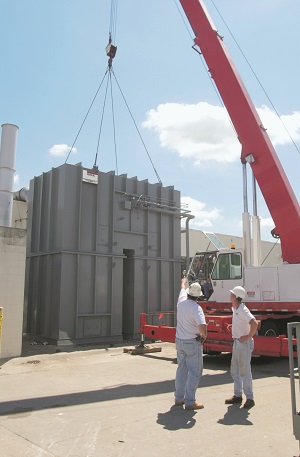
A more suitable technology choice emerged in the RTO. Emissions from the test cells were still low and this technology is extremely cost-effective at low concentrations with 95% thermal energy recovery typically achieved and options for up to 97% thermal energy recovery available. However, the existing RTO coupled to the concentrator controlling the paint processing did not offer the needed capacity or the upgraded materials of construction to provide resistance to corrosion.
Anguil engineers presented their analysis to the customer with all the control options available and the optimal technology chosen for treating the engine test cell emission was a new RTO. The engineering study, which considered the high quantity of water vapor and CO emissions, determined that all ductwork between the test cells and the RTO must be constructed of stainless steel to prevent corrosion. The ductwork was also sloped back to the process entry stream to minimize carryover of excessive amounts of water to the RTO. The oxidizer’s internal insulation and inlet ductwork were also designed to process the high amount of water vapor to minimize erosion of the RTO insulation and corrosion potential of the steel.
The system operation is very energy efficient with thermal energy recovery of 95% or higher. The process air containing VOCs passes through vertical beds of ceramic media that alternately stores and releases heat to elevate the process air temperature before it enters the combustion chamber. Since RTOs have such high heat recovery, the process air can be heated to a value very close to the combustion chamber set-point temperature. Heat released from VOC destruction during oxidation further elevates the process air temperature to the point where the RTO is often self-sustaining with no auxiliary fuel usage.
With this system, they elected to use supplemental fuel injection (SFI) that reduces the point of self-sustained operation to a lower process VOC concentration. Burners are shut off during operation with SFI which minimizes the introduction of combustion air into the chamber, and further reduces operating fuel usage with a flameless design that eliminates NOx emissions from the burner, problematic in some RTOs.
The manufacturing plant is now able to meet compliance on multiple emission sources while saving capitol expense. First, by utilizing equipment inherited with their plant purchase, plus the operational cost savings on the newer more efficient RTO. An additional benefit with selection of an RTO was to the environment. Although not required, RTOs control the CO emissions along with VOCs from the test cells. This facility can accommodate future expansion and stay in compliance for many years to come.

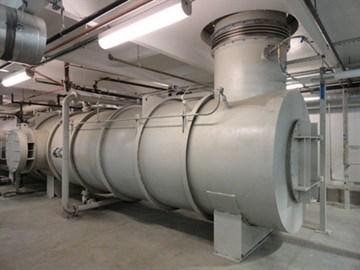 The Challenge
The Challenge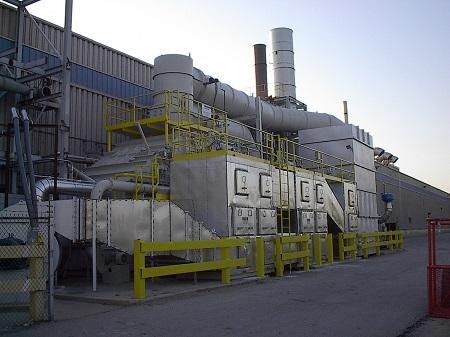 The Challenge
The Challenge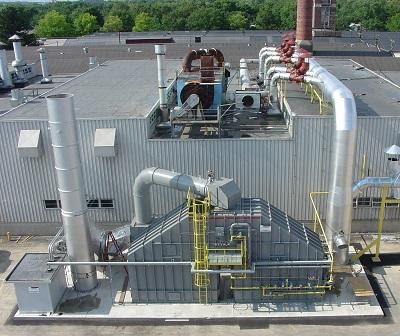 The Challenge
The Challenge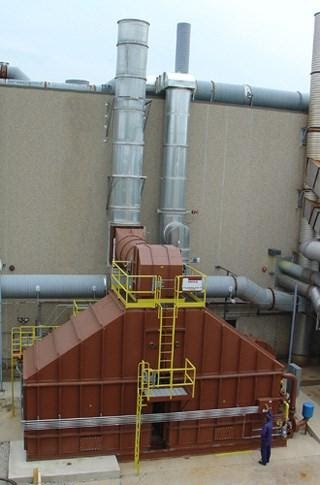 The Challenge
The Challenge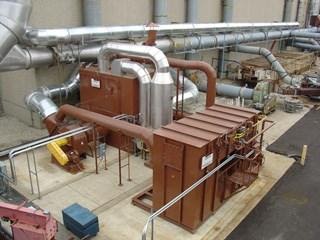 The Result
The Result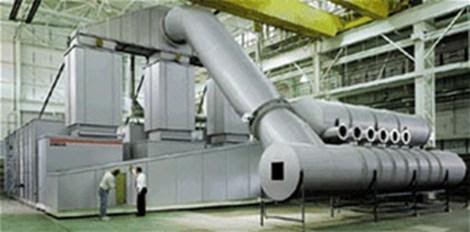 The Challenge
The Challenge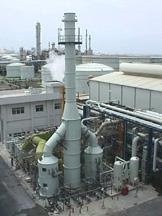 The Result
The Result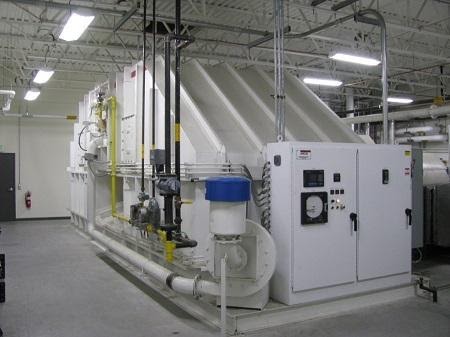 The Challenge
The Challenge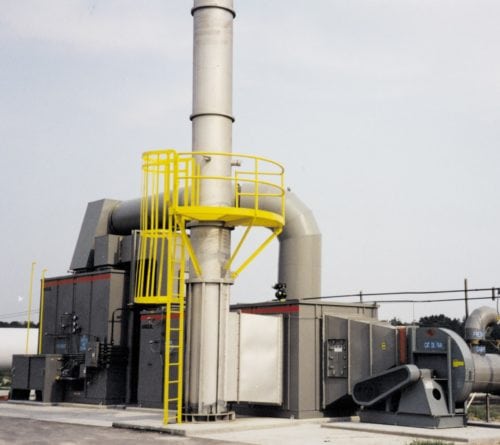 The Challenge
The Challenge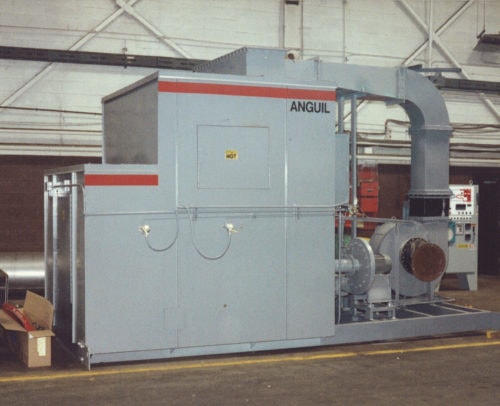 The Solution
The Solution